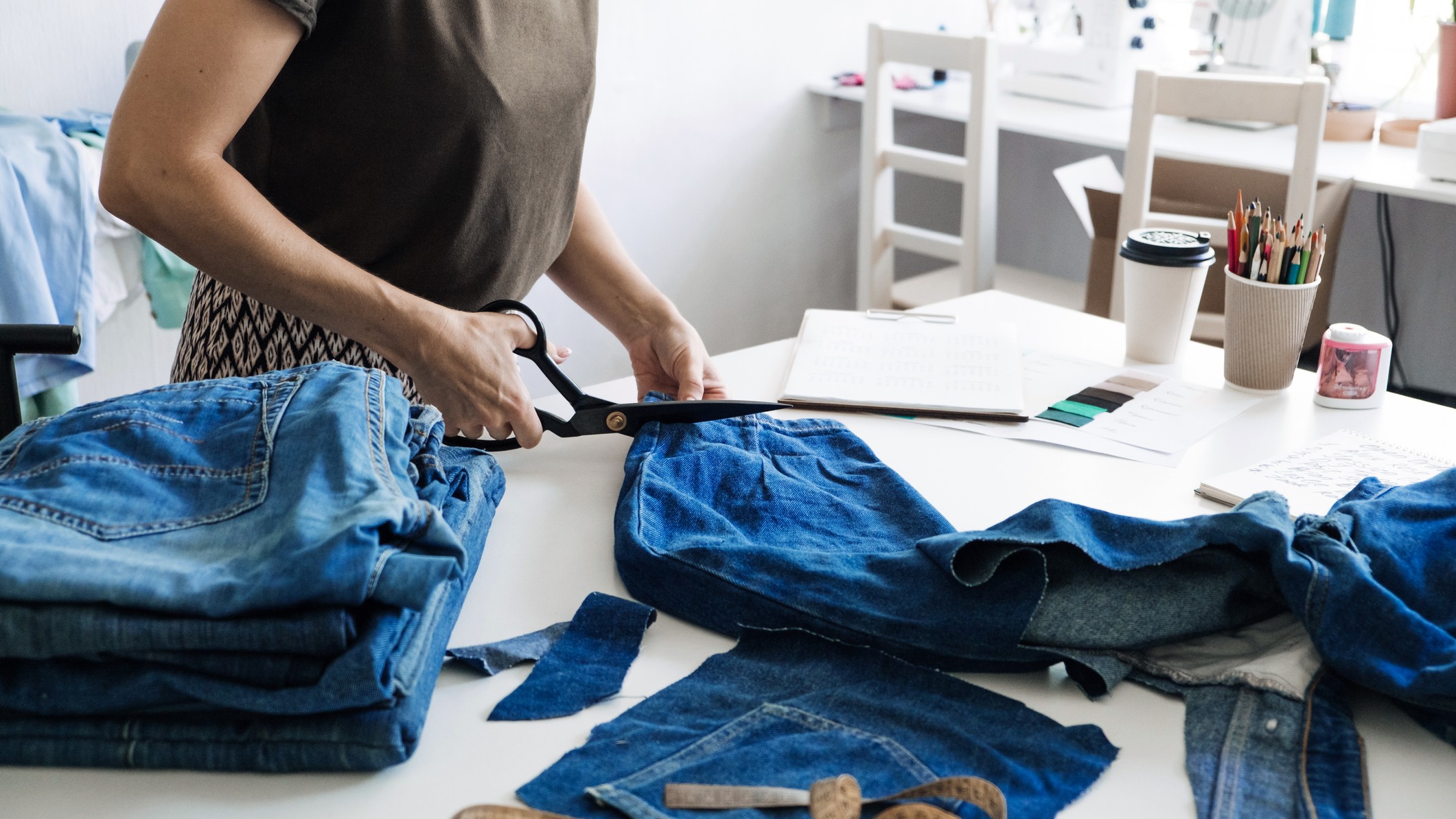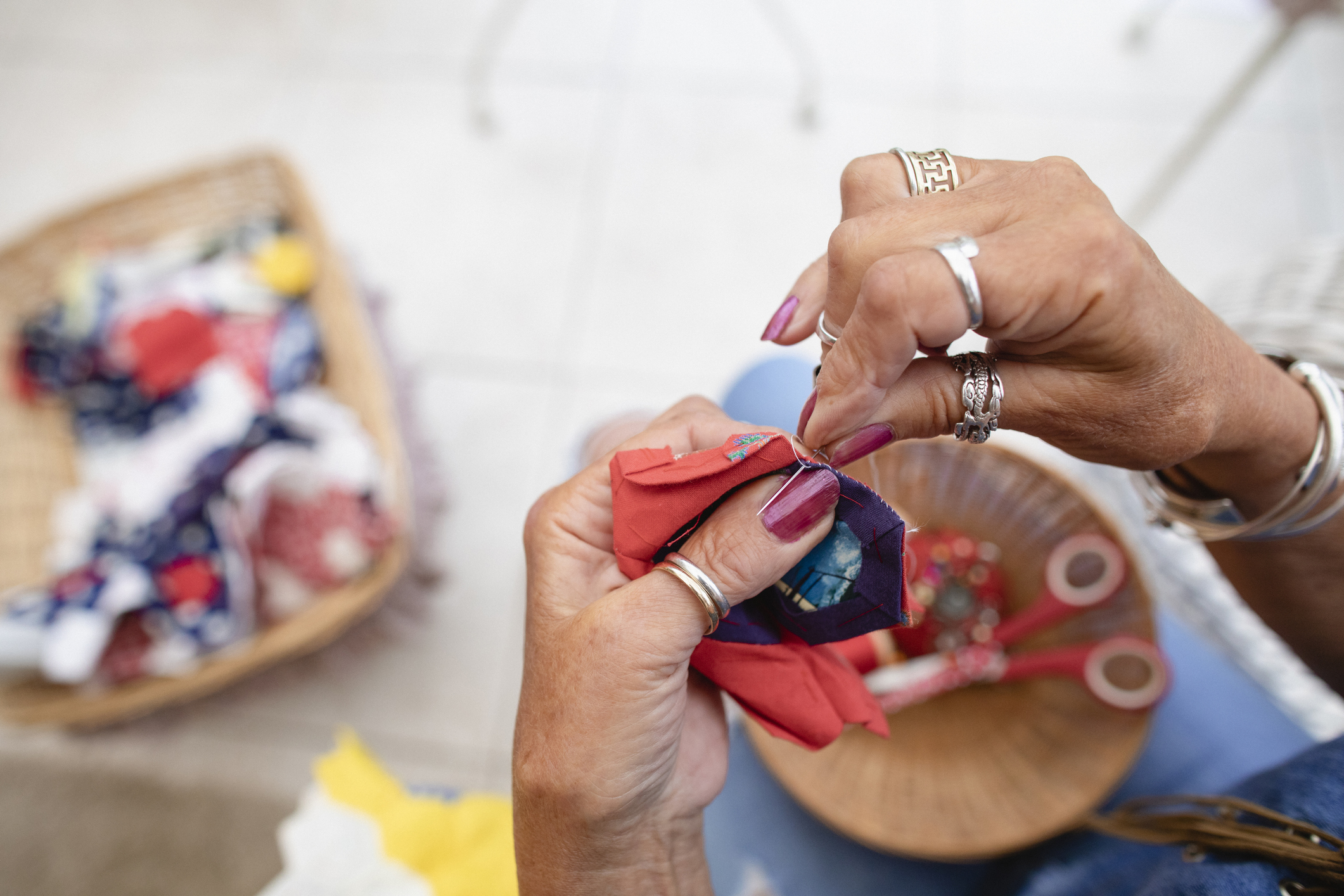Upcycled meaning: what is it and how does it differ from recycling?
It's a staple of sustainable fashion and homeware, but what is 'upcycled' meaning and definition?

We see it in product descriptions, in stores and on social media: upcycled. Meaning what, though? It seems to be a bit of a buzzword right now, with the tag #upcycling currently boasting nearly 3 million posts on Instagram. But what is its actual definition?
We're all trying to be more conscious and thoughtful about the brands and products we purchase, to make sure that they're ethically made and environmentally considered. Thankfully, plenty of clothing, accessory and beauty companies all offer plenty of stylish, carbon-conscious and eco-friendly items with which to fill our closets and vanities. But beyond buying from the best sustainable fashion brands and the best sustainable jewelry brands, there's another layer of sustainable shopping available for the carbon-conscious shopper to explore: thrifting, recycling, and, yes, upcycling.
Let's take a deep dive into all things upcycled: meaning, definition, upcycle ideas and how to add the "creative reuse" ethos into your own shopping habits.
Upcycled meaning and definition
Upcycling is the process of taking something used—fashion, furniture, anything really—and using it to create another good of higher quality or value than the original piece. The adage "one man's trash is another man's treasure" is incredibly applicable in the world of upcycling; often upcycled materials are salvaged on their way to the trash!
Second-hand things like wood pallets can become furniture or decor pieces, jeans can get torn up and turned into shorts or rugs, an old ladder is transformed into a bookshelf; you simply take something that is no longer in use and give it an entirely new purpose.
Upcycling vs recycling: how are they different?

You're probably thinking: "Wait, isn't upcycling just recycling then?" While there's definite overlap between upcycling (also known as "creative repurposing") and recycling, there are key differences.
Whereas upcycling takes existing products and materials in their original forms and gives them a new life, recycling involves sorting, processing, and altering those materials—melting metal cans, crushing old glass, breaking down wood—to turn it into the same product or a new product, with no regard to the materials' original form.
Because recycling often includes industrial production, an item can actually require less water, energy, and raw materials when it is upcycled—meaning, you can think of upcycling less as recycling and more as reworking.
What are the benefits of upcycling?
1. Supports craftsmanship and artisanal work
You aren't going to find many (or any) huge companies that use upcycled materials to create their goods, because upcycling cannot be manufactured. Each piece is as unique as the materials it is made of, which is a tall order for industrial machines.
For artisans with small businesses or sustainable indie companies, like these cool upcycled fashion brands, however, it not only gives each of their products a unique touch, but it saves them a lot of money on the cost of materials. Salvaged materials are free materials, which boosts their profit margins significantly.
When you purchase a product using upcycled materials, you are guaranteed to be supporting a small business owner, rather than a giant corporation—and we've all come to realize how important that is recently.
2. Minimizes use of natural resources
No matter what the old, unused item is made of—wood, rubber, metal, etcetera—its components can be traced back to natural resources, something that we all need to be careful stewards of.
When an object is made entirely from upcycled materials, no natural resources are used up. When we re-use those materials as part of our sustainable living efforts, we are giving Mother Nature a much-needed break.
- Sustainable vs ethical: what's the difference when you want to shop consciously?
- The best upcycled furniture ideas: five projects to DIY
- Upcycled garden ideas: doable DIYs for your outdoor space
3. Reduces manufacturing costs
As mentioned above, materials that are not being used are often offered for minimal (if any) cost. Getting second-hand materials drastically lowers the cost of production for upcycled products, and cuts out that manufacturing middle man who processes those materials into usable forms.
Instead of having someone buy a brand new piece of furniture, upcycling can turn a dining table into a bedside table (for example) that will actually be useful to someone, without anyone having to buy anything new. It's a win-win!
4. Reduces landfill waste

Oftentimes, materials used in upcycling products are rescued from dumpsters or landfill piles. Upcycling an item can also save it from entering landfill in the first place, as we consider another use for the piece.
We know that landfills are growing steadily, and everything we can do to mitigate that growth is important. If we can take items that can be upcycled out of the landfills, we can drastically improve the situation.
5. Helps to save the environment
Much like recycling, upcycling old items takes a huge strain off of our earth and its resources. Arguably, upcycling is a great way to decrease your carbon footprint, because of how little resources are used in the process of upcycling. Upcycling is not usually done on a big scale and is usually kept local, so the energy and water consumption are kept to a minimum.
What are some ways I can get involved in upcycling?
So you've heard about the meaning of upcycling and now know how it benefits our world—but how can you actually participate in it in your everyday life?
1. Seek out local businesses who use upcycling
As you know, many small, environmentally aware artisan shops use upcycling to create a lot of their products. Ask or look around your town or city to find businesses near you that employ this technique to create their goods. When you buy from them, not only will you be doing our environment a favor, but you will be supporting a small business that appreciates your patronage.
2. Try upcycling goods yourself
If you want to pick up a hands-on hobby and help out our earth, upcycling is perfect for you! Here are a few ways you can start:

- Take a look at ideas on Pinterest—Pinterest has no shortage of ideas when it comes to creative pursuits, and upcycling is no different. A simple search of "upcycling project" will return dozens upon dozens of ideas on what and how to upcycle, as well as pictures for inspiration, and blog posts on how to get specific projects done, whether you want to turn your old jumper into a cute crop top, or a spare plank of wood into a floating shelf.
- Visit garage sales and estate sales for inspo—A lot of upcycling depends on what kinds of materials you can find. Look around local thrift stores, garage sales, and estate sales to get an idea of what kinds of materials you could draw from. If you opt for something simple, like pallets or reclaimed wood, those should be easy enough to find. However, some projects require more niche materials. While this requires some creativity and know-how, it can be very exciting to look for a piece that you know will become the basis of a great upcycling project.
Once you have your project and upcycling piece picked out, all that's left is to get your remaining materials and get to work! Sometimes, the costs of things like paints or stains and other materials will be more than the purchase of the item itself, but you can cut costs even more by asking around for some second-hand materials.
It's also important to remember to protect your surroundings as you get started upcycling, as it can get messy! Try doing your DIY outside if you can, or dust paint sheets if inside to avoid damage from paint or tools.
Now that you know about all things upcycled—meaning and definition, the differences between it and recycling, and how to upcycle, go wild and try creative reusing for yourself!
The My Imperfect Life team is all about helping you navigate your world. We bring you the latest on fashion, beauty, travel and wellness so you can live life on your terms.